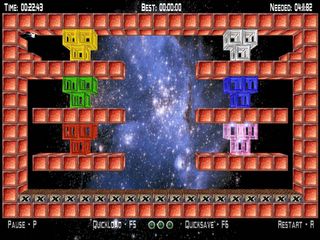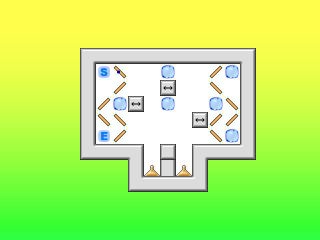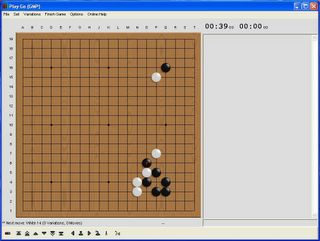Clockwiser
Title: Clockwiser
Author: IshiSoft
License: Freeware
Website: http://www.jrnetwork.co.uk/ishisoft/
This week's game, Clockwiser, was created as an entry for Retro Remakes 2006 competition. As part of that competition, IshiSoft was required to put in an initial splash screen containing the logos of the of the various competition sponsors. You have to click through this screen every time you start the game. This is an annoying form of in game advertising, something to which I am very opposed. I have decided to review Clockwiser anyways in large part because IshiSoft did not have a choice about the ad. I would understand if readers with higher standards just skip this one and come back next week.
In Clockwiser, the goal of each level is to make the left half the screen the same as the right half. To do this, you select a rectangle and rotate all of the items on its boundary one space clockwise or counterclockwise. After each rotation, gravity takes over. The colored squares simply fall. Bombs fall and destroy any neighboring items when they hit the bottom. Gems fall and multiply upon hitting bottom.

There are some other special items. There are bricks which do not feel the effects of gravity. They are especially useful if you want to elevate other items. There are wooden blocks which cannot be moved, but can be destroyed with bombs or converted to gems. There are anti-gravity tiles which counter gravity in that column. Finally, what would a puzzle game be without teleporters?
Clockwiser comes with 133 levels including 100 from the original game. Be sure to download the corrected level 74. The pacing of the levels is very good. The first 10 introduce the various items and then gradually get harder. There are some good challenges in here, but none of the levels are insanely hard. A level editor is included. One bummer is that you have to solve the level sequentially.
Clockwiser has two nice interface features. Each level comes with a time limit, but you can turn off this limit in options menu (thank you!). Another nice feature is an undo button. If make a bonehead move, you can take it back. Both make the game better.
There is one odd aspect to the rules which took me a while to understand. When a clockwise rotation is made on the left, the brick and bomb move together. On the right, the brick would move first. After the rotation, the bomb would drop and blow up itself and the brick.

All in all, Clockwiser is a great puzzle game with simple rules and fun, tough puzzles. It has great graphics, audio, and interface. As far as I can tell, it is bug free. What more could you want? No ads!
If you want info on the other entries in Retro Remakes 2006 competition, Tim W has short reviews of all of the entries in his Indy Gamer Blog.







